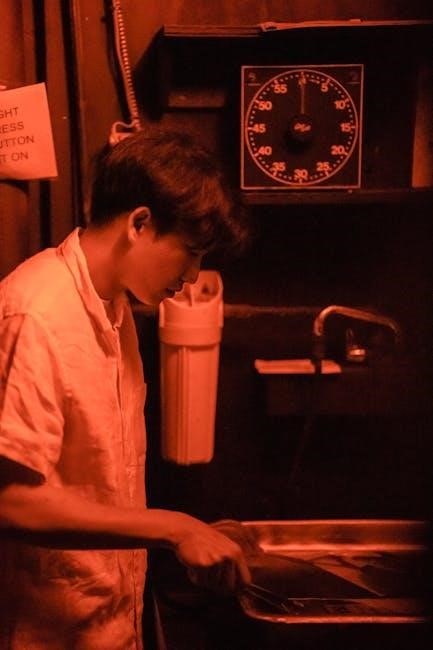
8145-20 defrost timer manual
This manual provides a comprehensive guide for understanding and installing the 8145-20 defrost timer, designed for commercial freezers and refrigerators to ensure efficient defrost operations and system reliability.

Overview of the 8145-20 Defrost Timer
The 8145-20 defrost timer is a robust, automatic control designed for commercial refrigeration systems, ensuring efficient defrost cycles to maintain optimal performance. It supports electric heat, hot gas, and compressor shutdown defrost systems, offering flexibility for various applications. The timer features a heavy-duty steel case with multiple electrical knockouts for easy installation. With adjustable defrost initiation frequency (1-6 times per day) and cycle duration (4-110 minutes in 2-minute increments), it provides precise control over defrost operations. The user-friendly design includes a rotating dial and trippers for setting defrost schedules, making it a reliable solution for commercial freezers and refrigerators.
- Supports multiple defrost systems (electric, hot gas, compressor shutdown).
- Adjustable defrost cycles for customized operation.
- Durable construction with versatile electrical connections.
- User-friendly interface for easy setup and management.

Importance of Proper Defrost Timer Installation and Setup
Proper installation and setup of the 8145-20 defrost timer are critical to ensure optimal performance and prevent issues in commercial refrigeration systems. Incorrect wiring or configuration can lead to defrost cycles not initiating or terminating correctly, causing ice buildup and system inefficiency. Additionally, improper setup may result in premature wear on components or even system failure. Following the manual’s guidelines ensures accurate defrost scheduling, aligns with the system’s specific needs, and maintains energy efficiency. Proper installation also guarantees safety, preventing electrical hazards and ensuring compliance with regulatory standards. Regular checks and adherence to maintenance schedules further support long-term reliability and performance of the timer and the overall refrigeration system.

Key Features of the 8145-20 Defrost Timer
The 8145-20 defrost timer offers adjustable defrost initiation frequency (1-6 times/day) and cycle duration (4-110 minutes), supporting various defrost systems like electric heat, hot gas, and compressor shutdown.
Adjustable Defrost Initiation Frequency
The 8145-20 defrost timer allows users to set the defrost initiation frequency between 1 to 6 times per day, providing flexibility to suit different applications and system needs. This feature ensures that defrost cycles occur as frequently as necessary, preventing excessive ice buildup without unnecessary energy consumption. The timer’s design enables precise control over when defrost cycles begin, optimizing system performance and maintaining optimal temperatures. By adjusting the frequency, users can tailor the defrost schedule to match the specific demands of their commercial refrigeration or freezer systems, ensuring efficiency and reliability.
Adjustable Defrost Cycle Duration
The 8145-20 defrost timer offers an adjustable defrost cycle duration, ranging from 4 to 110 minutes in two-minute increments. This flexibility allows users to customize the defrost cycle to meet the specific needs of their system, ensuring efficient ice removal without excessive energy use. By adjusting the duration, users can optimize defrosting for varying conditions, such as differing temperatures or system loads. The timer’s precise control ensures that defrost cycles are neither too short nor too long, maintaining system performance and preventing potential damage from ice buildup. This feature is particularly beneficial for commercial refrigeration systems requiring tailored defrosting solutions.
Contact Arrangements for Different Defrost Systems
The 8145-20 defrost timer accommodates various defrost systems, including electric heat, hot gas, and compressor off-cycle defrost. Its versatile contact arrangements ensure compatibility with different system configurations, allowing for seamless integration into existing setups. The timer’s design supports single-pole double-throw (SPDT) thermostats and other standard control mechanisms, making it adaptable to diverse refrigeration needs. This flexibility enables users to maintain optimal defrosting operations across multiple types of systems, ensuring reliable performance and system longevity. The timer’s robust electrical knockouts and heavy-duty steel case further enhance its durability and installation ease, making it a versatile solution for commercial refrigeration applications.

Installation and Wiring of the 8145-20 Defrost Timer
Refer to the wiring diagram for proper connections. Mount the timer securely, ensuring all electrical connections are tight. Connect line voltage to the designated terminals and set trippers according to the defrost schedule.
Step-by-Step Installation Guide
Begin by mounting the 8145-20 defrost timer in a dry, secure location near the freezer or refrigerator. Drill holes for the knockouts and ensure the timer is level. Connect the line voltage wires to the designated terminals, following the wiring diagram. Next, attach the defrost heater and evaporator fan wires to the appropriate terminals. Set the trippers on the timer wheel to match the desired defrost schedule, ensuring they align with the correct times. Tighten all connections firmly to prevent loose wires. Finally, test the system by initiating a manual defrost cycle to verify proper operation. Ensure the display shows the correct time and defrost status.

Understanding the Wiring Diagram
The wiring diagram for the 8145-20 defrost timer illustrates the connections needed for proper operation. It shows the line voltage input terminals and the output terminals for the defrost heater and evaporator fan. The diagram also highlights the limit switch connections, which are essential for terminating the defrost cycle. Color-coded wires simplify identification: red for hot lines, black for common, and white for neutral. The diagram also indicates the terminal for manual override functionality. Always refer to the diagram to ensure correct wiring, as improper connections can lead to system malfunctions. Use a multimeter to verify voltage at each terminal before powering up the system to ensure safety and reliability.
Voltage and Electrical Considerations
The 8145-20 defrost timer is designed for line voltage operation, supporting 120/208-240V AC, making it versatile for various commercial refrigeration systems. Ensure the timer is properly grounded to prevent electrical hazards and ensure reliable operation. The auto-voltage feature eliminates the need for separate timers for different voltages, simplifying installation. Always verify the voltage supply matches the system requirements before connecting. Overvoltage protection is built-in to safeguard the timer from power surges. For safety, disconnect power before performing any electrical work. Consult the wiring diagram for terminal connections and ensure all wires are securely fastened to avoid loose connections, which can cause malfunctions. Proper electrical setup ensures efficient defrost cycles and system longevity.

Operating the 8145-20 Defrost Timer
Set defrost start and end times using the rotating dial and trippers. Manual override allows initiating a 15-minute defrost cycle. The display shows defrost status, ensuring precise control and monitoring.
Setting the Defrost Start and End Times
To set the defrost start and end times on the 8145-20 timer, rotate the dial counter-clockwise to align the desired start time with the marker. Insert the defrost pins into the outer dial at the selected times to schedule cycles. Each pin represents a 15-minute interval. For multiple defrost periods, insert additional pins as needed. The timer will automatically initiate defrost at the set times, ensuring efficient operation. The lighted display confirms the schedule and active defrost status, providing clear monitoring. This feature allows precise control over defrost cycles, optimizing system performance and preventing ice buildup.
Manual Override and Emergency Defrost Activation
The 8145-20 defrost timer features a manual override option, allowing users to initiate defrost cycles outside of the preset schedule. This is particularly useful in emergency situations or when immediate defrosting is required. To activate manual defrost, simply move the switch to the “I” position, which overrides the timer and starts a 15-minute defrost cycle. The display will indicate the active defrost mode, ensuring visibility of the system’s status. This feature provides flexibility and control, enabling quick responses to unexpected conditions without disrupting the overall defrost schedule. The manual override function is a critical tool for maintaining system efficiency and preventing ice buildup during off-schedule periods.
Understanding the Display and Indicators
The 8145-20 defrost timer is equipped with a lighted display that provides clear status updates, ensuring easy monitoring of defrost operations. The display shows the current time, defrost start and end times, and active modes such as manual defrost. Indicators light up during specific operations, like when the defrost cycle is active or when a manual override is engaged. These visual cues help users quickly assess the system’s status without needing to access the internal settings. The display also alerts users to power loss events, ensuring awareness of any interruptions. This intuitive interface simplifies operation and maintenance, making it easier to manage defrost schedules and respond to system changes effectively.

Troubleshooting Common Issues
Identify faults in the defrost cycle, test the timer and limit switch, and resolve power loss issues. Ensure the defrost timer and system components function correctly for reliable operation.
Identifying Faults in the Defrost Cycle
Identifying faults in the defrost cycle involves monitoring the timer’s operation and system responses. Check if the defrost cycle initiates and terminates correctly. Ensure terminal 3 has power during the defrost phase, indicating proper timer activation. Verify the limit switch closes the circuit when pressure or temperature reaches the set point. Test terminals 3 and 4 for continuity and ensure the limit switch operates as intended. If the defrost cycle fails to start, inspect the timer’s trippers and wiring connections for damage or misalignment. Regularly check for worn or corroded contacts, which can disrupt the defrost process. Addressing these issues promptly ensures consistent and reliable defrost operations.
Testing the Timer and Limit Switch
Testing the timer and limit switch ensures proper defrost cycle operation. Start by verifying the timer’s electrical connections and checking terminal 3 for power during defrost. Use a multimeter to test continuity across the limit switch contacts to confirm they close correctly at the set point. Activate manual defrost to observe if the timer initiates the cycle and terminal 3 energizes. Check for any voltage drops or short circuits in the wiring. Ensure trippers on the timer wheel align with the desired defrost start times. If issues persist, consult the wiring diagram to trace connections and verify proper installation. Regular testing helps maintain reliable defrost functionality and prevents system malfunctions.
Resolving Power Loss and Schedule Retention
The 8145-20 defrost timer features 100 hours of power loss protection, retaining both time and defrost schedules. In case of a power outage, the timer automatically resumes its programmed settings once power is restored. To address power loss issues, ensure the battery connections are secure and functioning properly. If the display shows incorrect times after power restoration, manually reset the current time and defrost schedule. For persistent issues, consult the wiring diagram to verify all connections are intact. Regularly check the battery to ensure it can maintain the timer’s memory during outages. This feature ensures uninterrupted defrost cycles and maintains system efficiency, preventing ice buildup and operational disruptions.

Maintenance and Replacement
Regularly inspect and clean the timer’s electrical connections to ensure proper function. Replace the timer if it fails to maintain defrost cycles or shows signs of wear.
Regular Maintenance Tips
Regular maintenance ensures the 8145-20 defrost timer operates efficiently and extends its lifespan. Inspect electrical connections periodically to prevent corrosion or loose wiring. Clean the timer’s exterior and internal components to avoid dust buildup, which can disrupt functionality. Check the wiring diagram to confirm all connections align with the manufacturer’s specifications. Ensure the timer is mounted securely to prevent vibrations that could damage internal mechanisms. Test the defrost cycle manually to verify proper operation. Replace any worn or damaged trippers on the time wheel to maintain accurate defrost scheduling. Refer to the manual for detailed instructions on cleaning and part replacement. Regular maintenance helps prevent unexpected failures and ensures reliable defrost cycles.
When to Replace the Defrost Timer
The 8145-20 defrost timer should be replaced if it shows signs of wear or malfunction. If the timer fails to initiate or terminate defrost cycles properly, it can lead to system inefficiency or damage. Look for symptoms like inconsistent tripper alignment, power issues, or corrosion on electrical terminals. If the display becomes unresponsive or the timer does not retain its schedule after a power loss, replacement is necessary. Additionally, if manual override functions stop working or the defrost cycle duration cannot be adjusted accurately, it indicates a need for a new timer. Always use an OEM replacement part to ensure compatibility and performance; Regular testing and inspection can help identify when replacement is needed to maintain optimal system operation and prevent ice buildup in your refrigeration system.
Finding OEM Replacement Parts
To ensure optimal performance and compatibility, always use OEM (Original Equipment Manufacturer) replacement parts for the 8145-20 defrost timer. Genuine parts are designed to meet the exact specifications of your system, guaranteeing reliable operation and maintaining warranty validity. You can find OEM parts through authorized distributors or directly from manufacturers like Heatcraft. Online retailers such as Parts Town offer fast shipping and genuine products, ensuring you receive the correct replacement quickly. When purchasing, verify the part number (e.g., 8145-20) to avoid compatibility issues. Using non-OEM parts may lead to substandard performance or system malfunctions. Always check for the manufacturer’s seal or certification to ensure authenticity and quality. This ensures your refrigeration system operates efficiently and maintains its defrost schedule without interruptions.

This concludes the 8145-20 defrost timer manual. Proper installation, regular maintenance, and using OEM parts ensure optimal performance and longevity of your refrigeration system.
The 8145-20 defrost timer is a versatile and reliable solution for commercial refrigeration systems, offering adjustable defrost initiation frequency (1-6 times daily) and cycle duration (4-110 minutes). Designed for electric heat, hot gas, or off-cycle defrost, it features a heavy-duty steel case with multiple electrical knockouts. The timer replaces over 40 competitive models, simplifying installation and operation. With auto-voltage capability, it supports 120/208-240V AC systems, ensuring compatibility and ease of use. Proper installation, regular maintenance, and using OEM parts are crucial for optimal performance. This timer is ideal for maintaining efficient defrost cycles, preventing ice buildup, and ensuring long-term reliability in commercial freezers and refrigerators.
Best Practices for Long-Term Use
Regularly inspect and clean electrical connections to ensure proper functionality. Maintain the correct voltage supply as specified in the manual to prevent damage. Check defrost cycle duration and initiation frequency to suit your system’s needs, adjusting trippers as necessary. Avoid unauthorized modifications to preserve warranty and ensure safe operation. Use only OEM replacement parts for compatibility and reliability. Schedule periodic checks of the wiring diagram and limit switch to maintain defrost accuracy; Follow the manual’s guidelines for manual override and emergency defrost activation. Store the timer in a dry, cool environment when not in use. Adhere to the recommended maintenance schedule to prevent malfunctions and extend the timer’s lifespan. Proper installation and setup are key to long-term performance and efficiency.